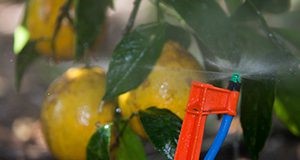Resumen
The use of water has become increasingly contentious because an increased population is sharing a decreasing amount of water. Water remains Florida’s most plentiful natural resource but is at risk as the agriculture industry and Floridians demand more water for a variety of uses. This 4-page fact sheet discusses the media’s influence on perceptions of agricultural water use, the measurement of attitudes and perception towards agricultural water use, and ways to educate the general public and local officials on this issue. Written by Courtney T. Owens, Alexa J. Lamm, and Ricky W. Telg, and published by the Department of Agricultural Education and Communication, April 2016.
Citas
Kim, K., Schluess, J., & Krishnakumar, P. (2015). 708 gallons of water were used to make this plate. Los Angeles Times. Retrieved from http://graphics.latimes.com/food-water-footprint/
Kingdon, J. W. (2003). Agendas, alternatives, and public policies. New York: Longman.
Kobylt, J. (2015). Personal communication on the KFI Radio show. Retrieved from http://www.cnbc.com/2015/04/15/california-drought-farmers-under-attack-for-heavy-water-use.html
Lamm, K. W., Lamm, A. J., & Carter, H. S. (2015). Mind the gap: Analyzing the differences in perceptions of water issues between the general public and agriculture and natural resource opinion leaders. Proceedings of the American Association for Agricultural Education Southern Region Conference, Atlanta, GA, 236-252. Retrieved from http://old.aaaeonline.org/uploads/allconferences/1-22-2015_743_2015_SAERC_Proceedings.pdf#page=236
Lamm, A. J., Owens, C. T., Telg, R. W., & Lamm, K. W. (in press). Influence of source credibility on agricultural water use communication. Journal of Applied Communication.
Lasorsa, D. (2008). Agenda setting. In L. Kaid, & C. Holtz-Bacha (Eds.), Encyclopedia of political communication. (pp. 13-20). Thousand Oaks, CA: SAGE Publications, Inc. doi: http://dx.doi.org.lp.hscl.ufl.edu/10.4135/9781412953993.n11 https://doi.org/10.4135/9781412953993.n11
Odera, E., Lamm, A. J., Irani, T., Dukes, M., Carter, H., & Galindo-Gonzalez, S. (2013). Water issues in Florida: How extension can facilitate stakeholder engagement and involvement. WC151. Gainesville: University of Florida Institute of Food and Agricultural Sciences. Retrieved from http://edis.ifas.ufl.edu/wc151 https://doi.org/10.32473/edis-wc151-2013
Patterson, L. (2012). 2012 RBC Canadian water attitudes study. RBC Blue Water Project. Retrieved from http://www.rbc.com/community-sustainability/environment/rbc-blue-water/index.html
Roper, C. G., & Lamm, A. J. (2014). Communicating with Extension Clients about Water. WC165. Gainesville: University of Florida Institute of Food and Agricultural Sciences. Retrieved from https://edis.ifas.ufl.edu/wc165
Schaible, G., & Aillery, M. (2012). Water conservation in irrigated agriculture: Trends and challenges in the face of emerging demands, EIB-99, U.S. Department of Agriculture, Economic Research Service. Retrieved from http://www.ers.usda.gov/media/884158/eib99.pdf https://doi.org/10.2139/ssrn.2186555
Telg, B., Jones, J., & Telg, R. (2015). Face-to-face storytelling. WC165. Gainesville: University of Florida Institute of Food and Agricultural Sciences. Retrieved from https://edis.ifas.ufl.edu/wc217
Telg, B., Jones, J., & Telg, R. (2015). Letting them in: Sharing your story with people outside of your industry. WC216. Gainesville: University of Florida Institute of Food and Agricultural Sciences. Retrieved from https://edis.ifas.ufl.edu/wc216
Young, S. T., & Dhanda, K. K. (2013). Sustainability; essentials for business. Thousand Oaks, CA: Ringgold Inc. https://doi.org/10.4135/9781544308432

